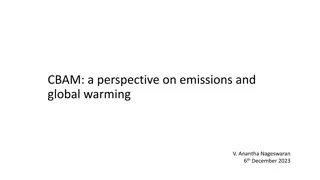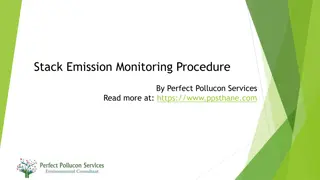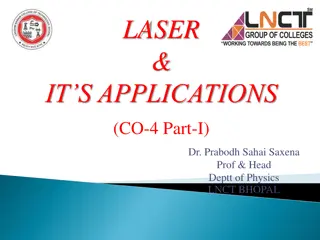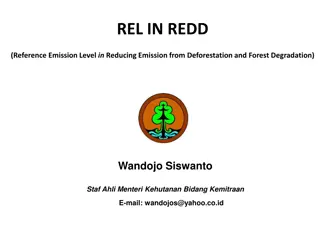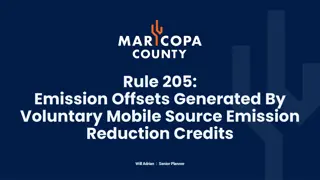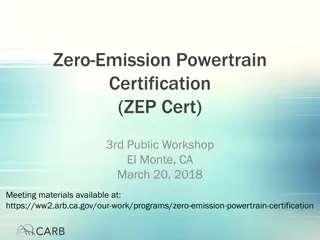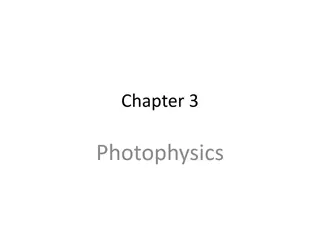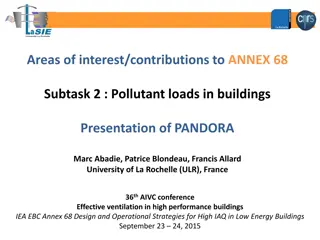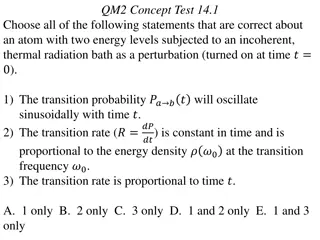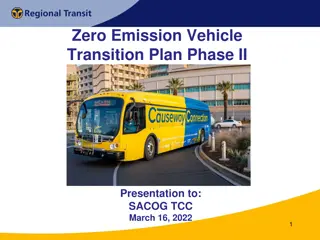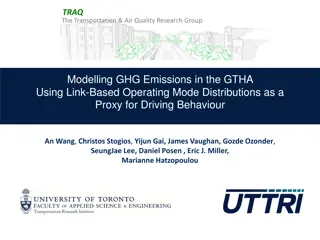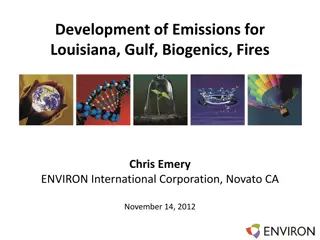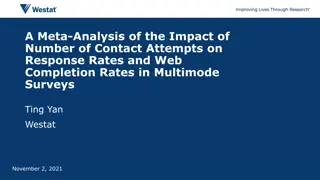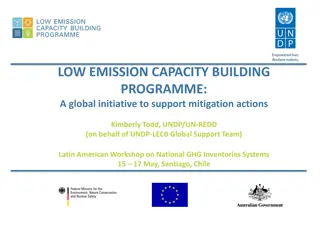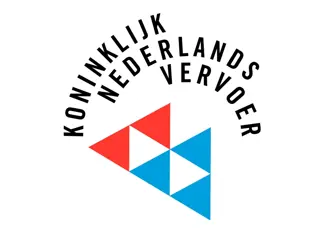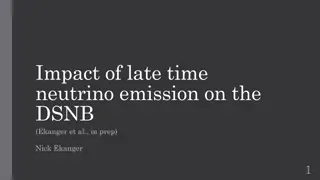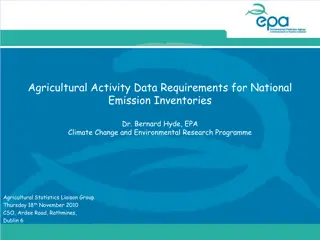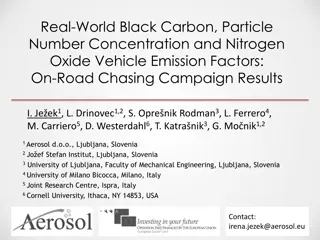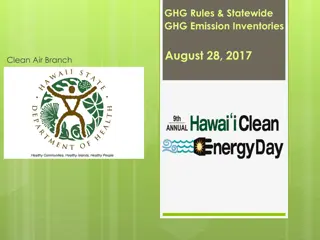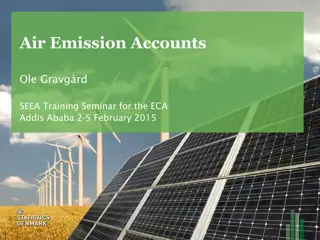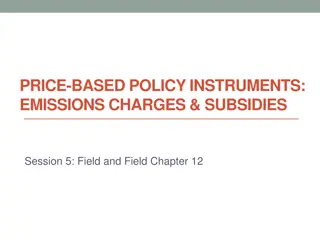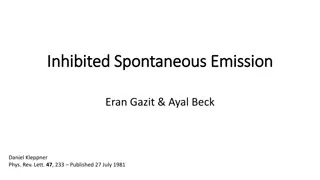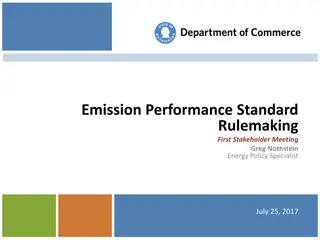Developing the CAST Highlight CO2 Emission Estimator (Beta) - February 2024
CAST Research Labs studied the impact of removing green deficiencies detected by CAST Highlight on CO2 emissions and energy consumption in custom software applications. The study led to a formula for estimating potential CO2 emission reductions, which was integrated into the new CAST Highlight CO2 E
0 views • 11 slides
CBAM: a perspective on emissions and global warming
Key considerations for Carbon Border Adjustment Mechanism (CBAM) and carbon pricing are discussed, emphasizing the complexity and inertia of transitioning to a low-emission economy, the need for durable emission reduction solutions, and the impact of non-optimal temperatures on global mortality rate
0 views • 7 slides
Efficient Stack Emission Monitoring Procedure for Air Quality Control
Stack emission monitoring is crucial for industries to assess and reduce pollutants in exhaust air. This procedure involves tasks like measurement, testing, and analysis of flue gases. Sampling sites are selected strategically for accurate readings, and molecular weight and gas velocity are determin
1 views • 11 slides
Understanding Laser Technology: Principles, Applications, and Einstein's Coefficients
Exploring the fascinating world of lasers, this content delves into the principles governing laser technology, including the concept of stimulated emission by Einstein. It covers the characteristics of lasers, different types, and the significant contributions of pioneers in the field. The explanati
0 views • 14 slides
Understanding Reference Emission Level in REDD
REDD (Reducing Emission from Deforestation and Forest Degradation) involves a system for producing carbon credits, including steps like setting baseline emission levels, devising deforestation reduction strategies, monitoring changes, managing carbon credit sales, and distributing income. Organizati
0 views • 10 slides
Computation of Machine Hour Rate: Understanding MHR and Overhead Rates
Computation of Machine Hour Rate (MHR) involves determining the overhead cost of running a machine for one hour. The process includes dividing overheads into fixed and variable categories, calculating fixed overhead hourly rates, computing variable overhead rates, and summing up both for the final M
4 views • 18 slides
Compliance Guide for Rule 205: Emission Offsets & Mobile Source Credits
Rule 205 outlines the process for generating emission offsets through voluntary mobile source emission reduction credits in Maricopa County. The rule-making process, state implementation plan submission, and permit conditions related to Rule 205 are discussed. The preparation for compliance includes
0 views • 7 slides
New Mexico Graduation Rates 2018-2019 Analysis
The New Mexico Public Education Department utilizes a Shared Accountability Model to calculate graduation rates, considering students' time enrolled at each school. Graduation rates are calculated after a two-step verification process, with on-time graduates in focus. Historical data shows a positiv
0 views • 13 slides
Understanding Chemical Kinetics: Rates, Reactions, and Mechanisms
Chemical kinetics involves studying reaction rates, rate laws, stoichiometry, and factors affecting reaction speed. This branch of chemistry delves into determining reaction orders, rate constants, and activation energies using various methods. Different types of rates, such as initial, instantaneou
2 views • 68 slides
Understanding the Principle and Working of Semiconductor Lasers
Semiconductor lasers operate through absorption, spontaneous emission, and stimulated emission processes. Absorption of radiation causes electrons to jump to higher energy levels, leading to light emission. Spontaneous emission is when excited electrons return to ground state by emitting photons, wh
3 views • 17 slides
Zero-Emission Powertrain Certification Workshop Highlights
Workshop materials and agenda from the Zero-Emission Powertrain Certification 3rd Public Workshop held in El Monte, CA on March 20, 2018, discussing the ZEP Cert framework, applicability, testing, monitoring requirements, and more. The workshop aimed to accelerate the adoption of zero-emission techn
1 views • 24 slides
Understanding Photophysics: Emission and Luminescence Processes
Photophysics explores the emission and loss processes in luminescent phenomena, named based on the excitation mode of energy-rich species. Different types of luminescence include fluorescence, phosphorescence, and chemiluminescence. Bioluminescence in nature, such as in fireflies and dinoflagellates
0 views • 20 slides
Understanding Chemical Kinetics: Reaction Rates and Mechanisms
Chemical kinetics is a branch of chemistry focused on studying reaction rates and mechanisms. Unlike thermodynamics, which deals with feasibility, kinetics explores the speed at which reactions occur. Factors such as temperature, pressure, and catalysts influence reaction rates. Understanding the ra
3 views • 72 slides
Emission Requirements Discussion at 3GPP TSG-RAN-WG4 Meeting #99-e
Discussion at the 3GPP TSG-RAN-WG4 Meeting #99-e focused on emission-related radiated requirements for DL and UL in relation to adjacent channel protection in NR specifications. Various options and candidates for defining ACLR were explored, along with considerations for spurious emissions and OBUE
1 views • 5 slides
PANDORA: Indoor Air Pollutant Emissions Database Presentation
Delve into the comprehensive PANDORA database, developed by LaSIE at the University of La Rochelle, focusing on emission rates of gaseous and particulate pollutants from various sources in buildings. Explore emission models, basic and overall structures, and the main interface for understanding and
3 views • 10 slides
Quantum Mechanics Concept Tests 14
Explore quantum mechanics concepts related to atoms, energy levels, perturbations, transition probabilities, and emission rates. Understand the behavior of two-level systems under various perturbations and the dynamics of transitions in hydrogen atoms. Dive into calculations involving transition rat
0 views • 7 slides
Insights into Radio and X-ray Emission in Radio-Quiet Quasars
Radio galaxies are categorized as radio-loud or radio-quiet based on the presence of jets and lobes. Unlike radio-loud quasars, the nuclear radio emission in radio-quiet quasars does not originate from large-scale jets. Possible explanations include broad absorption lines, magnetically accelerated e
0 views • 15 slides
Zero Emission Vehicle Transition Plan Phase II Presentation to SACOG TCC
California Air Resources Board (CARB) mandated the transition to 100% zero-emission fleets by 2040 for all transit agencies, leading SACOG to roll out Zero Emission Bus (ZEB) programs. The ZEV Planning Phase II report details the introduction, garage concepts, ZEB transition, costs, and next steps i
0 views • 10 slides
Thyroid Cancer Survival Trends in Europe: Eurocare-5 Study
A population-based study on thyroid cancer survival rates in Europe over 25 years reveals insights by sex, country, age, period, and histological type. The study shows increased incidence but stable mortality trends, with varying survival rates based on region, gender, and histology types like papil
0 views • 14 slides
Modelling GHG Emissions in Greater Toronto Area Using Link-Based Operating Mode Distributions
The Transportation & Air Quality Research Group's study focuses on generating a lifecycle emission inventory for transportation in the Greater Toronto Hamilton Area (GTHA). They aim to incorporate uncertainty in the emission inventory and quantify the impact of electric vehicles on total emissions.
0 views • 35 slides
Detailed Overview of Emissions Development in Louisiana
Emissions Processing System (EPS3) generates chemically speciated, gridded formats required by CAMx, with a focus on raw annual/ozone season county/parish-level emission inventory files and support data. Spatial and temporal profiles, along with cross-reference files, are essential for this work, co
1 views • 27 slides
Impact of Number of Contact Attempts on Response Rates in Multimode Surveys
This meta-analysis investigates the effects of the number of contact attempts on response rates and web completion rates in multimode surveys. Benefits of multimode surveys include improving coverage, increasing response rates, reducing costs, and enhancing measurement accuracy by utilizing multiple
0 views • 27 slides
Global Low Emission Capacity Building Programme Overview
The Low Emission Capacity Building Programme is a global initiative by UNDP aimed at enhancing capacities for designing and implementing Low Emission Development Strategies and national mitigation actions in various sectors. It includes components like GHG inventory management, NAMAs, LEDS, MRV, and
0 views • 12 slides
Understanding Unit Rates in Mathematics
Explore the concept of unit rates in mathematics, where you will learn how to determine unit rates of given quantities and solve word problems involving unit rates. Discover key vocabulary, such as ratio, rate, and terms, and understand the difference between ratio and rates. Delve into examples and
0 views • 22 slides
Insights into the Dutch Coach Industry and Low Emission Zones
Discover the Dutch coach industry landscape, including the market share of KNV members, emission regulations in low emission zones, and challenges faced by coach companies like Leo Ringelberg Touringcars. Explore how KNV is advocating for cleaner coaches and addressing restrictions in important tour
0 views • 17 slides
Zero Emission Vehicles: Forecasting Fleet Scenarios & Emissions Implications
This research project, conducted by Louis Berger U.S. Inc. & Sonoma Technology Inc., explores the implications of adopting zero emission vehicles through forecasting fleet scenarios and estimating emissions reductions. The study assesses the potential increase in zero emission vehicle population, em
0 views • 42 slides
Understanding Exchange Rate Behavior with Negative Interest Rates: Early Observations by Andrew K. Rose
In this study, Andrew K. Rose examines the exchange rate behavior in economies with negative nominal interest rates, focusing on the impact and implications of such rates on exchange rates. The findings suggest limited observable consequences on exchange rate behavior, with similarities in shocks dr
0 views • 42 slides
Greenhouse Gas Emissions Management in Warehouse Operations
The SQAS Assessor accreditation training in April 2022 focused on measuring and reducing greenhouse gas emissions in warehouse operations. The content covers emission questions, scope of emissions, energy consumption examples, disaggregation of emissions, emission intensity calculation, and strategi
0 views • 17 slides
Symposium on Positron Emission Tomography and Boron Neutron Capture Therapy Time-Over-Threshold Calibration in J-PET
The 3rd Symposium on Positron Emission Tomography and 1st Symposium on Boron Neutron Capture Therapy focused on Time-Over-Threshold calibration within the framework of J-PET. The event outlined experimental details, event selection, results, and key features of the Jagiellonian Positron Emission Tom
0 views • 35 slides
Applications and Importance of X-ray Fluorescence Spectroscopy in Analytical Chemistry
X-ray Fluorescence Spectroscopy (XRF) is a vital analytical technique used for qualitative and quantitative analysis of elements based on their X-ray emission characteristics. Dr. Uma Sharma, a Professor at Vikram University, details various X-ray analytical methods, including X-ray emission, Auger
0 views • 21 slides
Late-Time Neutrino Emission Impact on DSNB Study
Explore the implications of late-time neutrino emission on the Diffuse Supernova Neutrino Background (DSNB) through core collapse supernovae simulations. The research delves into the dynamics of neutrino emission in different phases of supernova events and its relevance to understanding the DSNB.
0 views • 15 slides
Agricultural Emission Inventory Data Reporting Requirements
This presentation discusses the data requirements for national emission inventories in the agricultural sector, covering greenhouse gas inventories, air pollutant inventories, National Inventory Reports, Large Combustion Plant Directive, National Emission Ceilings Directive, livestock emissions, and
0 views • 13 slides
Real-World Black Carbon & Nitrogen Oxide Vehicle Emission Factors Study
This study presents real-world data on black carbon (BC) and nitrogen oxide (NO) vehicle emission factors gathered through on-road chasing campaigns. The research explores the influence of dilution and vehicle performance on emission factor calculations, with a focus on measuring emissions from vehi
0 views • 13 slides
Hawaii Statewide Greenhouse Gas Emission Rules Overview
The Hawaii Statewide Greenhouse Gas (GHG) Emission Rules implemented by Act 234 in 2007 aim to limit statewide GHG emissions to 1990 levels by 2020. The rules include setting emission caps for stationary sources, conducting annual evaluations to track progress, and reporting GHG inventories regularl
0 views • 9 slides
Understanding Air Emission Accounts and Bridge Tables
Flows of air emissions, including gaseous and particulate substances released into the atmosphere, are recorded in Air Emission Accounts following specific guidelines and considerations. Bridge tables play a crucial role in reconciling differences between national economy totals and emission invento
0 views • 18 slides
Understanding Emission Charges for Environmental Policy
Explore the concept of emission charges as a policy instrument, where firms pay charges for every unit of effluent discharged to reduce emissions. The regulator sets the price to achieve efficient emission levels. Learn about setting charges in competitive environments, total abatement costs, and th
0 views • 18 slides
Colorado Greenhouse Gas Tracking & Reporting Overview
This content provides detailed information about Colorado's Greenhouse Gas Tracking & Reporting, Greenhouse Gas Reduction Targets, Verification Workbook, Emission Rates, and Key Items for Reporting/Tracking in a Day Ahead Market or RTO. It outlines the methodology, targets, and requirements for redu
0 views • 5 slides
Exploring Inhibited Spontaneous Emission in Physics
The study delves into inhibited spontaneous emission in physics, focusing on the phenomena, experimental setups, and effects like the Purcell effect. It discusses using waveguides and Rydberg atoms for this purpose, as well as the density of modes and states in free space and cavity configurations.
0 views • 16 slides
Washington State Emission Performance Standard Rulemaking Stakeholder Meeting Overview
This document provides detailed insights into the first stakeholder meeting regarding the Emission Performance Standard Rulemaking in Washington State. It covers key agenda items, reviews of RCW 80.80 GHG Emission Performance Standard, definitions related to CCCT and baseload electric generation, an
0 views • 19 slides
Enforcing Compliance with Minimum Emission Standards in Priority Areas Overview
Workshop on the enforcement of minimum emission standards in priority areas, focusing on compliance requirements, challenges faced by key industry players like Eskom and Sasol, and the process of seeking postponements for meeting standards. Detailed insights into the regulatory framework, stakeholde
0 views • 20 slides

